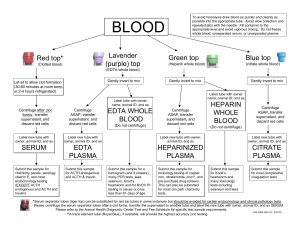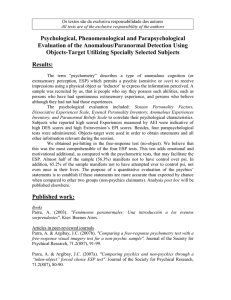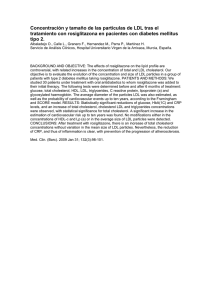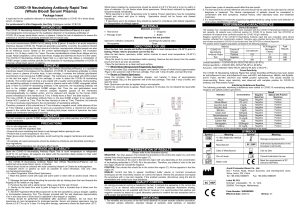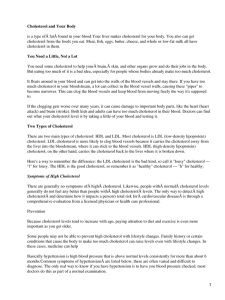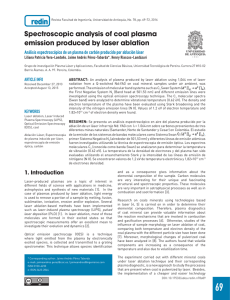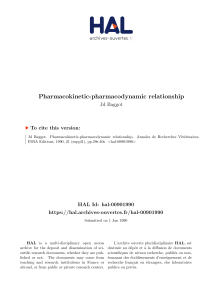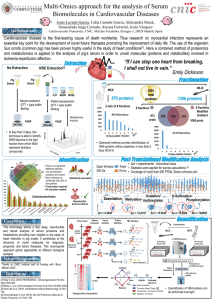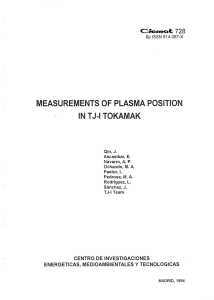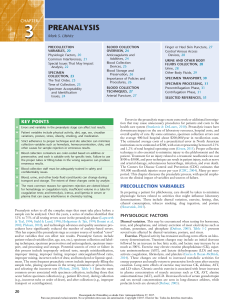PLASMA LIPIDS AND LIPOPROTEINS IN THE GRASS
Anuncio
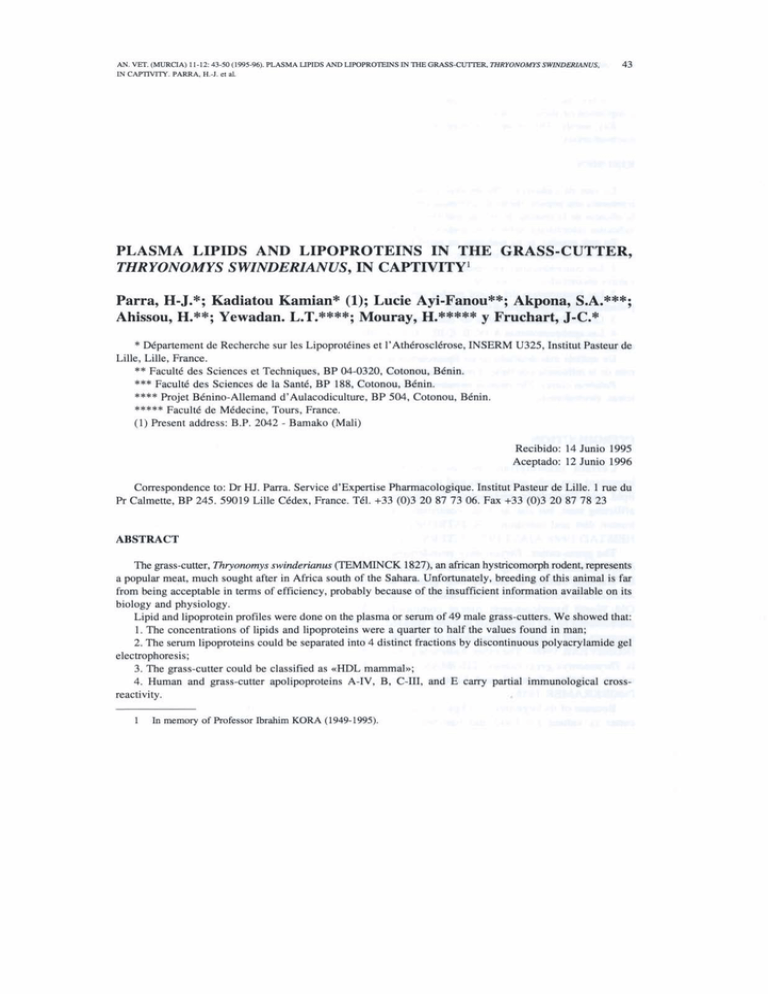
m.(MURCIA) 11-12:43-50 (IQW?~). PLASMA L I P AM> ~ LIP~PROTEWSIN 'IHB GRASS-CUTIER IN CAPIIVITY. PARRA. K-J. ct al. AN. mrowmm ~ R . Z J ~ W U 43 S . PLASMA LIPIDS AND LIPOPROTEINS IN THE GRASS-CUTTER, THRYONOMYS SWZNDERIANUS, IN CAPTIVITY' Parra, H-J.*; Kadiatou Kamian* (1); Lucie Ayi-Fanou**; Akpona, S.A.***; Ahissou, H.**; Yewadan. L.T.****; Mouray, H.***** y Fruchart, J-C.* * Département de Recherche sur les Lipoprotéines et I'Athérosclérose, INSERM U325, Institut Pasteur ae Lille, Liile, France. ** Faculté des Sciences et Techniques, BP 04-0320, Cotonou, Bénin. *** Faculté des Sciences de la Santé, BP 188, Cotonou, Bénin. **** Projet Btnino-Allemand d'Aulacodiculture, BP 504, Cotonou, Bénin. ***** Faculté de Médecine, Tours, France. (1) Present address: B.P. 2042 - Barnako (Mali) Recibido: 14 Junio 1995 Aceptado: 12 Junio 1996 Correspondence to: Dr W. Parra. Sewice d'Expertise Pharmacologique. Institut Pasteur de Lille. 1 me du Pr Calmette, BP 245.59019 Lille Cédex, France. T61. +33 (0)3 20 87 73 06. Fax +33 (0)3 20 87 78 23 ABSTRACT The grass-cutter, Z b y o ~ ~ mswinderiaruls ys (TEMMINCK 1827), an gfricanhyshicomorph rodent, W n t s a popular me&, much sought after in Africa south of the Sahara Unfortunately, breeding of this animal is far from being acceptable in terms of effíiency, probably because of the insufficient infarmation avdable on its biology and physiology. Lipid and lipoprotein profiles were done on the plasma or serum of 49 maie grass-cutters. We showed that: 1. The concentrations of lipids and lipoproteins were a quarter to half the vaiues found in man; 2. The serum lipoproteins could be separated into 4 distinct fractions by discontinuous polyacrylamide gel electrophoresis; 3. The grass-cutter could be classified as eHDL mammai*; 4. Human and grass-cutter apolipoproteins A-IV, B, C-m, and E carry partial immunological m s reactivity . 1 In memory of Rofeesor Ibrahim KORA (1949-1995). 44 AN. VET. (MiJRCiA) 11-12: 43-50 (1995%). PLASMA llPlDS AM> LIPOPROTEiNSIN THE - G THRYONOMYS S W W D W U S , IN CAPTIVITY. PARRA, KJ.et sL Further characterization of the grass-cutter lipoproteins is needed as is the investigation of the role of diet composition on these profiies. Key worrls: Thryonomys swinderianur, grass-cutter, plasma, lipids, lipoproteins, apolipoproteins, electmphoresis. RESUMEN La rata de cañaveral, Thryonomys swinderianui (TEMMINCK 1827), roedor histricomorfo africano representa una popular hente de alimentación, muy apreciada en Africa al sur del Sahara Desgraciadamente, la eficacia de la crianza de este animal está lejos de ser aceptada, probablemente debido a que no se tiene suficiente información sobre su biologia y su fisiologia. En este estudio, se ha realizado un perfil lipídico y üpoproteico plasmiitico sobre 49 ratas de cañaveral machos. Los resultados muestran que: 1. Las concentraciones en lípidos y lipoproteínas de la rata de cañaveral se sitúan entre 114 a 112 de los valores encontrados en el hombre. 2. Las lipoproteínas del animal pueden separarse en 4 fracciones distintas por electroforesis sobre gel de poliacrilamida en gradiente discontinuo. 3. La rata & cañaveral puede ser considerado como un «mamífero de HDL». 4. Las apolipoproteínas A-IV, B. C-iil y E del hombre y de la rata de cañaveral presentan una identidad antig6nica común. Un análisis más detallado de las lipoproteínas de este animal deber6 ser realizado, así como la investigación de la influencia que tiene el régimen alimentario en estos perfiles. Palabras claves:Thryonomys swinderiaR~.rata de cañaveral, plasma, iípidos, lipoproteínas, apolipoproteínas, electroforesis. INTRODUCTION Certain mammalian species are very important, not only as experimental models for lipid and iipoprotein metaboiism in diseases afflicting man, but also as direct contributors to human diet and nutrition (ARMSTRONG and HEISTAD 1990; AJAYI 1971; PETERS 1987). The grass-cutter, Thryonomys swinderianus (TEMMINCK 1827) (Fig. l), which is localized in Westem Africa is one of two genera of Aulacoda in Africa south of the Sahara; it is an Old World hystricomorph rodent commonly encountered in the herbaceous and tree-studded savannas, and in marshy areas aiong river banks (ROSEVEAR 1969). The other Aulacoda genus is Thryonomys gregorianus (THOMAS 1894). which inhabits Central and Eastem Africa (MORKRAMER 1988). Because of its large size (3-7 kgs.), the grasscutter is valued for food and has become a popular meat, much sought after, in Benin and generally in Westem Africa (AJAYI and TEWE 1980; MORKRAMER 1988). As a consequence of the increasing demand, poaching and hunting have contributed greatly to the dramatic disappearance of the grass-cutter species (MARTIN 1985; ANADU et al. 1988). So, for the conservation of a natural resource providing a ~ i g ~ c aamount nt of animal protein. attempts at breeding have been made in many countries of Westem Africa (HEYMANS and MENSAH 1984; MENSAH 1985; BAPTIST and MENSAH 1986;ADENUI 1986). Unfortunately and in spite of some positive results, breeding efficiency is far from being acceptable, not only because little is known about the grass-cutter's life in captivity, but also because insufficient infonnation is available on the animal's biology and physiology. In order to contribute to the knowledge of its biology, the aim of this paper is therefore to AN. VEi. (MURQA) 11-12: 43-54 (1995-96). PLASMA LiPiDS AND UPüPROiEiNS IN ?HE GRASSIN CAPTNITY. PARRA, H.-J. et d. THRYONOMYSSWINDERUNUS, 1 . ' T r r-7 -'FmF 45 FIGURE1. The grass-cuüer, Thryonomys swinderianus (TEMMJNCK 1827), in captivity. present basic data on plasma lipids and lipoproteins in the grass-cutter, Thryonomys swihrianus. MATERIALS AND METHODS Animals and sampling blood Forty nine randomly selected male grasscutters were studied; they were bred on the Projet Bénino-Allemand d'Aulacodiculture's animal farm in Cotonou (Benin) and were at least 1 year old, with body weights ranging between 1 and 3 kgs. They were kept individually in 1 m3 parks under natural conditions of light and temperature, and were fed a standardized fodder diet that contained fresh-cut grasses (Pannicum maximum and Pennisetumpurpureum) eaten by these animals in the wild (E1969; AJAYI and TEWE 1980), supplemented with a stock concenuate feed developed at the fann (43.4% wheat starch, 26.0% brewery c i d , 21.0% maize grain, 5.0% sugar-cane molasses, 3.0% dry leaves of Lezaena leucocephala, 1.0% oyster shell, 0.5% cooking salt and 0.1 % vitamin rnix). For chemical compositions see Table 1 (YEWADAN 1992). Water was provided ad libitum. To obtain blood samples, the animals were fasted overnight and then restrained for about 20 mn by anaesthesia with a soludon of equal volumes of Imalgene 500 (RhBne Merieux) and Rompun (Bayer) (100 pikg). Subsequently, blwd was coliected by intracardiac puncture into dry or citrate-containing tubes. Serurn or plasma was then separated by low-speed centrifugation and, after addition of preservatives (final concentrations: EDTA, 0.27 mmolil; E-amino-n-caproic acid, 0.9 mmolll; chloramphenicol, 0.6 mmoY1; and glutathione, TABLE 1 Chemicai composition of the standard grass-cutter diet (% of dry matter) Nutrient Stock concentrate feed Fodder (granuiatedfeed) Carbohydrates Proteins Fats Crude cellulose Minerals Calcium Phosphate 0.3 mmoM), immediately mailed to Lille, at +4"C, for iipid and iipoprotein analyses within 48 h. Human serum was collected by venipuncture from 10-12 h fasting ostensibly heaithy normolipidemic men recruited at the Center for Preventive Medicine at the Institut Pasteur in Lille. Rat serum was obtained from fasted (14 h) maie Wistar rats (Iffa-Credo, L'Arbresle, France) by retro-orbital venous plexus puncture. Analyticai methods Pli-WfImtal cholesteroi, Iree cholesterol and free fatty acids were determined by enzymatic colonmetric methods (Boehringer-Mannheim, Germany). Cholesterol in high densitylipopmteins (HDL-cholesterol) was measured in the supematant after precipitation of VLDL, IDL and LDL (very low-, intermediate- and lowdensity lipoproteins) with phosphotungstatel MgCl, (Boehringer-Mannheim). Total triglycendes and phospholipids were detennined by enzymatic kits from Biotrol (Paris, France) and from BioMérieux (Marcy l'Etoile, France). respectively. Electrophoresis of whole s e m or iipopmtein fractions was performed on ready-to-use polyacrylamide gel slabs marketed by Sébia (Issy-les-Moulineaux, France), and constnicted 59.2 19.0 6.2 10.8 5.2 0.7 0.9 43.2 10.6 2.3 34.3 7.2 0.4 0.3 to give a discontinuous gradient from 2% (at point of sample loading) to 3% (running gel). Monospecific antibodies against human apolipoproteins (apo) A-1, A-11, A-IV, B, C-III, and E were raised in rabbits; the antigens injected were punfied by preparative ultracentrifugation and anion-exchange chromatography (MEZDOUR et al. 1987). Antibodies against iipoprotein (a) were from Irnmuno Diagnostika (Vienna, Austria). Immunological crossreactivity of grass-cutter apolipoproteins with these anti-human apolipopmtein antibodies was checked by counter-immunoelectrophoresis (Immuno Diagnostika). Data are expressed as mean f SD. The MannWhitney U-test was used to test differences for significance. RESULTS The data for the plasma lipid and lipoprotein parameters in grass-cutters, compared to man and rat, are shown in Table 11. There was a wide individual variation within animals for most pararneters, giving large standard deviations. Free and total plasma cholesterol, triglycendes, phosphoiipids and free fatty acids in grass-cutters were approximately a quarter to a half the values present in man, while HDL-cholesterol was about half the concentrations found in man; AN. VET. (MURCiA) 11-12: 43-93 f 1995-%). PLASMA LiPiDS AND LIWPRíilEWSM THE F í'&WWMYS SWIrYiXWAhWS, 47 M CAPiIVITY.PARRA,H.-J. w al TABLE U Concentrations of plasma lipid and lipoprotein in grass-cutters compared to man and rat (values are expressed as mean f SD) Parameters (gA) Grass-cuiter n=49 Total cholesterol Free cholesterol (% of total) HDLcholesterol (% of total) Tnglycerides Total phospholipíds Free faíty acids* 0.542I0.200 O. 1 W . 0 5 5 (26.1) 0.29110.149 (52.7) 0.34739.158 0.64310.227 0.187&0.151 Man n=30 1.75110.219b 0.445f0.075b (25.4) 0.516f0.176b (29.8) 0.845f0.340b 1.964&0.256b 0.648I 0.345b Rat n=10 0.655I0.104" 0.1 1310.028 (17.3) 0.491I 0.113b (74.4) 0.829M.394b 1.230M.487b 0.701M.18gb * rnmoM; * Significantly different from values for grass-cutters: 'p=0.025; [email protected]. FIGURE 2. Comparison of the polyacrylamide gel electrophmkis paaerns of grass-cueher (1,4,7), human (2J) and rat (3,6) whole senim. Simples were prestained with Sudan black. T& m w indicates the jundon af t h 2 and 3% gels. Lp: Lipoprotein. however, the proportions of free to total cholesterol in grass-cutters and man were similar (21.6 vs 25.4%). On the other hand, the concentrations of free and total cholesterol in grass-cutter and rat were of the same magnitude, while triglycerides and phospholipids were lower and the proportion of free cholesterol higher in the former. In grass-cutter, as in rat, but unlike man, the main amount of cholesterol was in the HDL fraction (on average 52.7% of total cholesterol). After electrophoresis of grass-eutter serum, at least 4 bands were visible: one with a-mobility (HDL),two with Bmobility O L , and LDLJ and one blocked right at the start af the running gel corresponding to human and rat pre-R 48 AN. VRi'. (MURQA) 11-12: 43-8) (1995-96). PLASMA UPIDS AND LIWPROTEINS M THB ORASSCUITW. THRYONOMYS SWINDERIANUS, M UPTNiTY. PARRA,H.J.e1 a l P~GURB 3. immunological reactivity of p s s - a t t e r whole m m (B) with antisera to human apolipoproteins (A) upon counter-immunoe~oresis:anti apo A1 (1,8); anti apo A11 (2); anti apo AiV (3.9); anti apo B (4,lO); auti apo Cm (5); anti apo E (6); anti apo (a) (7). The slides were stained for protein with Ponceau S. lipoproteins (VLDL) Vig. 2). As can be seen, human a-migrating HDL have a higher electrophoretic mobility than those of the grasscutter which represent the more intensely stained band, as in rat serum (Wistar strain). In human serum, the 6-migrating LDL band was more intense, while in the rat, the a- and pre-Bmigrating bands were the dominant lipoprotein fractions. Unlike the rat, a-migrating LDL bands (6, and 6,) in the grass-cutter's serum were clearly visible on the electrophoresisgel (Fig. 2). Immunological cross-reactivity of grasscutter apolipoproteins with various anti-human apolipoprotein antibodies was re-nted in Fig. 3. Grass-cutter's plasma reacted very positively with anti-human apo A-IV and B. and less strongly with anti-human apo C-iii and E. No positive immunological reactivity was observed with anti-human apo A-1, A-11 and liw~rotein (a). DISCUSSION Plasma lipids and lipoproteins in rodents -such as mouse, rat, rabbit, guinea pig- are amply described in the literature, including their isolation, ongin and function (CHAPMAN 1986). However, and to our knowledge, no information is available concerning the lipid and lipoprotein profile of the grass-cutter Zkryonomys swinderiunus (TEMMINCK 1827). So, this is the first study providing basic information on the plasma lipid and lipoprotein parameters in this african rodent which represents a very high nutritional feature in many countries of Africa, south of the Sahara. Our results showed that, as in the rat, lipid and lipoprotein concentrations in the grass-cutter were approximately a quarter to half the concentrations found in man. Furthermore, the AN.m.(MURCIA) 11-12: 43-50 (1995-96).PLASMA LIPIDS ANO LiWPROTIBNS IN llE GRASS-CüTiEü,THRFONOMYSS W I N D W S , 49 M CAPITVITY. PARRA. H J.M al grass-cutter appears grossly similar to other rodents since it carries a very large portion (52.7%)of its cholesterol in its HDL fraction; it could be classified as a «HDL mammal*. This last aspect was in accordance with the electrophoretic profile in that the a-migrating fraction (HDL) was the major component of the grass-cutter's serum. The slower migration of this fraction, when comparied with human serum, might indicate that the animal's HDL were larger than their human counterparts, which generally corresponds to a ncher triglyceride content. As can be obsemed in Fig. 2, the grass-cutter had two slow-moving LDL bands (B, and 6, lipoproteins)which were of much lower relative concentration than the relative LDL concentration of humans, but of a much higher relative concentrationthan those of the rat. LDL represent the lipoprotein class which is of great interest in atherosclerosis studies, and the rat, a widely used animal model for studying lipoprotein metabolism, is almost totally lacking in this component. The major purpose of the present study was to contribute to the knowledge of grass-cutter's biology. However, it should be kept in mind that animal models continue to have important roles in human disease research. Unfortunately, no single species fulfills the scientific and practical requirements for being a good model, and it is often necessary to use several animal models to investigate al1 aspects of a given disease. With regard to lipoprotein metabolism and atherosclerosis research, the grass-cutter might have advantages over the rat because its basa1 lipoprotein profile showed 4 distinctly stained bands; furthermore, another advantage of the grass-cutter is its large body size allowing more frequent and important blood sampling. It is well lcnown that high levels of serum cholesterol are associated with increased development of aiherosclerosis in most species and that a positive association exists between dietary saturated fat and atherosclerotic vascular disease. The role of diet composition in cholesterol metabolism has been studied extensively in animais. In rabbits, for example, it has been found that changes in the levels of serum cholesterol due to modulations of the protein sources in the diet, paralleled the degree of aortic lesions et al. 1982). Thus, the effects of the nature and the proportion of protein in the diet on the concentration of serum cholesterol might be of great importante in the development of atherosclerosis.Wle the rat is very resistent to the development of atherosclerosis, except in case of consumption of a very high-chlolesterol diet together with the administration of thiouracil and cholic =id (HADJIISKY et al. 1991), this kind of infonnation is not available for the grass-cutter. 1x1this study, our animals were fed a standadbd diet developed at the farm. Further studies are therefore necessary to investigate the role of diet composition on the lipid and lipoprotein profile of the grass-cutter. Finally, in this report giving basic data on the plasma lipids and lipoproteins of the animal, we have shown that, as in other rodents, the levels were approximately a quarter to half the values found in man. We also showed by electrophoresis that the grass-cutter has four distinct bands of plasma lipoproteins. However, more sensitive procedures will be required to isolate and characterize these bands; this work is being conducted presently in our laboratory. We thank Mrs Anne Montpeiiaz for expert secretaria1assistance, Miss Nadbge B6thenwurt and Mr Séraphin L. M'Pili for verifying and improving the English of the manuscxipt, and Mr Oscar Perez Mendez for the spanish abstract. This investigation was supported in par1 by the «Projet Campusm of the eMinist&reFrangais de la Coopération~. 50 AN. VIT. (MURCIA) 11-12: 43-54 (1995-96). PLASMA UPIDS AND LIWPROTEDIS iN THE GRASSCUTIW, THRYONOMYSSWLNDWWLNUS, M CAPTMW. PARRA, H.-J. el aL ADENTJi, KO. 1986: Livestock breeding in Africa World Review of Animal Froduction, 21(1), 65-72. AJAYI, S.S. 1971: Wild life as a source of protein in Nig&a: some priorities for development. Nigerian Field, 36(3), 115-127. AJAYI, S.S. and TEWE, 0.0.1980: Food preferente and carcass composition of grass-cutter (Thryotwmys swinderianus) in captivity. Afn'can Journal of Ecology, 18, 133-140. ANADU, P.A., ELAMAH, P.O. and OATES, J.F. 1988: The bushmeat trade in southwestern Nigeria: a case study. Human Ecology, 16(2), 199-208. ARMSTRONG, M.L. and HEISTAD, D.D. 1990: Animal models of atherosclerosis. Atherosckrosis, 85. 15-23. BAPTIST, R. and MENSAH, G.A. 1986: The cane rat - Farm animal of the future? Worid Animal Review, 60.2-6. CHAPMAN, M.J. 1986: Comparative analysis of marnmalian plasma lipoproteins. Methods in En~ymology,128.70-143. EWER, R.F. 1969: Form and function in the grasscutter Thryonomys swinderianus Temminck (Rodentia, Thryommidae). Ghana Journui of Science, 9(2), 131-141. HADJIISKY, P.; BOURDILLON, M.C. and GROSGOGEAT, Y. 1991: Modeles expérimentaux d'athérosclérose. Apports, limites et perspectives. Archives des Maladies du Coeur, 84, 1593-1603. HEYMANS, J.C. and MENSAH, G.A. 1984: Sur l'exploitation rationnelle de l'aulacode - rongeur Thryonomyidé - en R.P. Bénin - Données préliminaires. Tropicultum, 2(2). 56-59. HUFF, M.W.; ROBERTS, D.C.K. and CARROLL, KK. 1982: Long-term effects of semipurified diets containing casein or soy protein isolate on atherosclerosis and plasma lipoproteins in rabbits. Atherosclerosis, 41, 327-334. MARTIN, G.H.G. 1985: Carcass composition and palatabiiity of some wild animals commonly used as food. Worid Animal Review, 53,40-44. MENSAH, G.A. 1985: Rapport final des études préliminaires sur l'élevage de l'aulacode (Thryonomys swinderianus) au Bénin. Notes techniques sur l'élevage N0.0.2.3 Cotonou, M.D.R.A.C. MEZDOUR. H.; CLAVEY, V.; KORA, 1.; KOFFIGAN, M.; BARKIA, A. and FRUCHART, J.C. 1987: Anion-exchange fast protein liquid chromatographiccharacterizationand purification of apolipoproteins AI, AII, CI, CII, CiiIO, Cml, C m 2 and E from human plasma. J o u m l of Chromatography, 414. 35-45. MORKRAMER, G. 1988: L'aulacode c o m e source de ravitaillement de 1'Afrique en viande. TrypanotoIémnce et Production Animale, 5: 4148. PETERS, K.J. 1987: Classification et utiiisations possibles du Wtail non conventionnel. Bulletin du CIPEA, 27,3743. ROSEVEAR, D.R. 1969: The rodeas of WestAfBca. London: Trustees of the British Museum (Natural History) 541-588. TEMMINCK, C.I. 1827: Aulacodus swinderianus Temminck 1827. Monographies de m ~ ~ a l o g i e 1, Sierra Leone. 248. THOMAS, 0. 1894: Description of a new species of reed-rat (aulacodus) from East Africa, with remarks on the milkdentition of the genus. Annals and Magazine of Natural History Xm,Ser 6, 202-204. YEWADAN, L.T. 1992: 1st Conference on grasscutter production. Achievements and prospects 17-19 Febmary, Cotonou (Republic of Benin).

